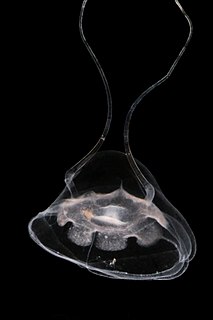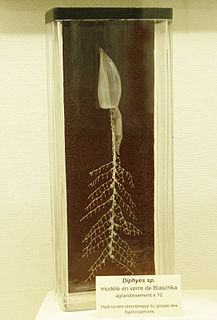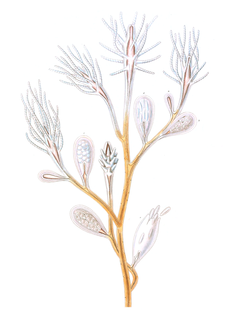
A salp or salpa is a barrel-shaped, planktic tunicate. It moves by contracting, thereby pumping water through its gelatinous body, one of the most efficient examples of jet propulsion in the animal kingdom. The salp strains the pumped water through its internal feeding filters, feeding on phytoplankton.

Members of the genus Metridium, also known as plumose anemones, are sea anemones found mostly in the cooler waters of the northern Pacific and Atlantic oceans. They are characterized by their numerous threadlike tentacles extending from atop a smooth cylindrical column, and can vary from a few centimeters in height up to one meter or more. In larger specimens, the oral disk becomes densely curved and frilly.

Hydroidolina is a subclass of hydrozoans in the phylum Cnidaria. It contains the bulk of the paraphyletic "Hydroida" which were one of the main groupings of the class Hydrozoa in older classifications and were placed at order rank. Hydroidolina also includes, however, the highly advanced colonial jellies of Siphonophora, which were not included in the "Hydroida".

Rhopalonematidae is a family of hydrozoans. The family comprises 15 genera and 36 species.

Haleciidae is a family of hydrozoans. Their hydroid colonies emerge from a creeping hydrorhiza and usually form upright branching colonies, although some species' colonies are stolonal. Their gonophores are typically sporosacs, growing singly or bunched into a glomulus. They remain attached to the hydroids or break off to be passively drifted away; in a few, the gonophores are naked.

Solmundella is a genus of hydrozoan in the family Solmundaeginidae. It is monotypic, with the single species Solmundella bitentaculata.

Hiatella is a genus of small saltwater clams, marine bivalve molluscs in the family Hiatellidae.

Corynidae is a family of hydrozoans in the order Anthomedusae.

Hydractiniidae is a cnidarian family of athecate hydroids.

Podothecus is a genus of poachers native to the northern Pacific Ocean.
Maeotias is a genus of hydrozoans in the family Olindiidae. It is a monotypic genus with only a single species, Maeotias marginata, commonly known as the Black Sea jellyfish or brackish water hydromedusa and often referred to as Maeotias inexpectata in the literature. It was first described from the Don and Kuban estuaries of the Sea of Azov, and also occurs in the Black Sea, all of which are areas of low salinity. It has been recorded in several other estuarine locations around the world and is regarded as an invasive species.

The Diphyidae are a family of siphonophores. These are colonial siphonophores with two nectophores arranged one behind the other. The front one includes a somatocyst, while the hind one does not. The somatocyst often contains an oil droplet for buoyancy control. A nectosac in each nectophore allows the organism to swim efficiently.

Muggiaea is a genus of siphonophores in the family Diphyidae. Members of this family are colonial siphonophores with two nectophores arranged one behind the other, but in the genus Muggiaea, the posterior nectophore is absent. The anterior one has a complete dorsal ridge. The somatocyst is very close to the nectosac wall.

Capitata is a suborder of Hydrozoa, a class of marine invertebrates belonging to the phylum Cnidaria.

Filifera is a suborder of hydrozoans in the order Anthoathecata. They are found in marine, brackish and freshwater habitats.

Aplanulata is a suborder of Hydrozoa, a class of marine and freshwater invertebrates belonging to the phylum Cnidaria. The group have lost its planula larval stage, and the only remnants of the medusa stage is when they functions as gonophores attached to the polyp.

Cordylophora is the sole genus of hydrozoans in the monotypic family Cordylophoridae.

Cunina is a genus of hydrozoan in the Cuninidae. The genus contains bioluminescent species.
Abyla is a genus of siphonophore in the Abylidae. The genus contains three species, some of which are bioluminescent.
Schuchertinia is a genus of commensal athecate hydroids in the family Hydractiniidae.


















